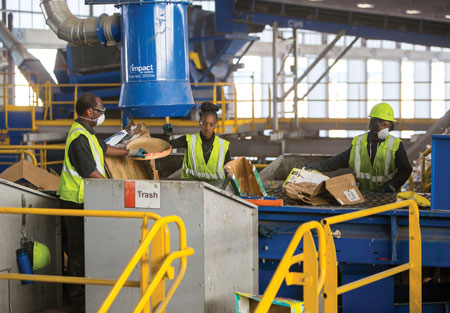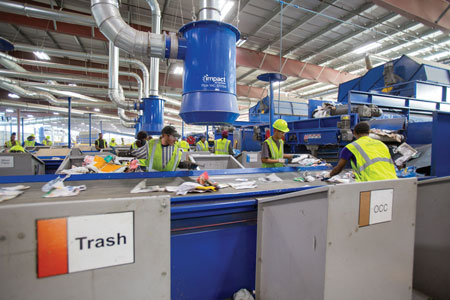Understanding the right market wage for general labor, paying people fairly and treating them well are keys to getting results.
By Patrick Hudson
MRF operators from coast-to-coast face a common conundrum: how to control the cost of labor to meet P&L (Profit and Loss) targets. The typical levers to pull are reducing overtime, squeezing staffing company markups or cutting headcount. It is a balancing act.

When any of these tactics are used, MRFs may hit their net cost goals, but that metric can come at the expense of production and efficiency. With fewer people working fewer hours, productivity suffers, quality is negatively impacted and revenues decline. It is a death spiral that can be hard to escape. As an option, MRF managers may choose to cut wages to meet their facility’s budget. When this course is taken, it is typically to ask the question: “How low can we go?”
The more strategic question to ask is: “What wage will get us the best workers in this market at this time?” We advocate a new approach to tackling the dual problems of balancing P&L targets and wage rates, one that focuses first on making a more valuable product and second on attracting a workforce that will contribute to your productivity.
We believe a key component is paying a competitive market wage to MRF employees. Now, before you dismiss this approach as impossible to sell, unlikely to work or unnecessary in your market, hear us out. You are right to ask, “Tell me how this works. Give me an example.” Here are two case studies that demonstrate the value of thinking differently about MRF headcount and wages.
Headcount: An Indicator, Not an Outcome
In mid-2019, Leadpoint was hired to implement its high-performance work team model at a large municipal MRF. When Leadpoint’s Operations Support Team first came into the plant, the recovery/residual was 65/35. That is not bad, but everyone—the city, site management, and Leadpoint’s team—knew it could be better.
Leadpoint worked with the city to understand their goals and align the company’s approach with the city’s KPIs. A top priority was a consistent workforce, so Leadpoint stopped focusing on headcount and focused instead on what it would take to recruit not just the right number, but also the right quality of employees.
Leadpoint also conducted a market wage analysis to determine the hourly pay rate that would allow the MRF to recruit employees who would both stay on the job and contribute to the site’s success.
The data indicated a wage increase of $1 per hour would keep the city more competitive in the market. Although it was tough, the customer agreed. Then, Leadpoint did three more things to ensure that this wage increase would pay off:
1. Ongoing training. Leadpoint’s employees get in-depth training when they are first hired but it does not stop there. When a new employee is fully competent in the job, onsite managers conduct training and hand speed tests every day—not because hand speed is the key metric, but because hand speed only matters if sorters are picking up the right material. “When we train and test daily, it ingrains the desired behavior. Sorters know their hand speeds, how they are improving, and what they need to do to meet the customer’s standards,” said Albert Pena, Leadpoint Operations Support Team manager.
2. Personalized coaching. Beyond just testing and training, Leadpoint parses the data to learn when each sorter is most productive and what type of work best matches their skills. Are they faster on the container line or on OCC? Are they best in the morning or do they slump right after the lunch break? This level of detail allows us to manage each employee to their strengths and weaknesses. If someone has a high, accurate pick count, the training does not stop—it accelerates! The sorter begins cross-training for other jobs within the MRF. The ultimate goal is for everyone to be cross trained in all lines, so the customer is assured that Leadpoint has people available to cover for absences without missing a beat.
3. Include equipment in the equation. Leadpoint’s Operations Support Team works closely with onsite managers and customers to get the MRF’s equipment where it needs to be. “We collaborate, recommend and adjust various pieces of equipment to make our workforce more effective. We firmly believe it’s critical to understand the people and the machinery to get the highest productivity from each,” Pena said.
The result? Within 90 days of implementing Leadpoint’s processes, the city re-audited the site and found the recovery/residual ratio improved to 75/25, without adding a single headcount.

Market Wages Drive Recruiting and Retention
Understanding the right market wage for general labor, paying people fairly and treating them well are keys to getting results. That is the lesson Leadpoint demonstrated at a southern U.S. MRF where they took over the workforce from a traditional staffing company late last year.
As in the previous example, Leadpoint started with a wage analysis. The data indicated an increase of $1/hour would be competitive in the market and would get the MRF the results they were looking for.
The customer balked. An increase of $1/hour translated into a big number they simply could not swallow. Leadpoint capitulated and did their best to meet the site’s headcount and budget goals. While progress was made, it was not enough.
After 90 days, Leadpoint went back to the customer and presented the wage data and recommended hourly increase again. The second time, they agreed. In just over a week, Leadpoint had a 180 degree turn in recruiting and retention. Here is what happened:
• The additional $1/hour wage generated a dramatic increase in the number of applicants. Leadpoint also started getting referrals from existing employees and from the customer.
• With more people available to work on the site’s rotating schedule, Leadpoint was able to reduce overtime. “Instead of consistently working 10 to 12-hour shifts to keep up with demand, we were able to hold employees to straight eight-hour shifts, which kept costs down,” Pena said.
• Keeping shifts to eight hours or less in the first few weeks increased retention. “Being a sorter is hard work, especially for new employees who have to get used to the physical stresses of the job. When we previously needed employees to work longer shifts because we had fewer employees overall, it was too much for them and many left the job after only a few days,” says Pena.
• The number of recordable injuries dropped. Why? By not working new sorters more than eight hours at a time, and by treating their muscle soreness with topicals, employees were able to avoid more serious injuries and Leadpoint was able to prevent misclassification of soft tissue injuries.
• The customer noticed a positive change in the quality of talent Leadpoint was hiring. They noted that this higher caliber workforce was more adaptable to sorting, learned the job more quickly, and performed better overall.
Thinking Differently: The Payoff
As these two case studies demonstrate, determining the right wage and taking the bold step of offering higher pay for sorters yields dividends for MRF operators. It allowed Leadpoint to recruit and attract a higher-caliber employee and demand more from each sorter on the line.
When MRFs pay a market wage, turnover declines, attention to safety improves and a better product is produced, with less contamination. Staying vigilant, coaching and training delivered continuous improvement in productivity, efficiency and profitability once the workforce was hired. Rather than cutting into a site’s profitability, raising wages empowers MRFs to sell their product at a higher price. Their reputation improves along with their bottom-line results. | WA
Patrick Hudson is Vice President of Sales and Marketing for Leadpoint Business Services (Phoenix, AZ). Leadpoint can conduct a complimentary market wage analysis for your site. It is the first step in implementing at high-performance work team that will relieve you from focusing on headcount and shift the focus to productivity, efficiency and profitability. For more information, examples or to reach Patrick, call (888) 205-1511 or e-mail [email protected].
Get more information at www.leadpointusa.com
You may also like:
7 Principles for Building Teamwork in Recycling Plants
Leadpoint and Tri-County Recycling: Success Built on Collaboration
